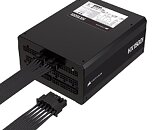- Joined
- Oct 9, 2007
- Messages
- 47,670 (7.43/day)
- Location
- Dublin, Ireland
| System Name | RBMK-1000 |
|---|---|
| Processor | AMD Ryzen 7 5700G |
| Motherboard | Gigabyte B550 AORUS Elite V2 |
| Cooling | DeepCool Gammax L240 V2 |
| Memory | 2x 16GB DDR4-3200 |
| Video Card(s) | Galax RTX 4070 Ti EX |
| Storage | Samsung 990 1TB |
| Display(s) | BenQ 1440p 60 Hz 27-inch |
| Case | Corsair Carbide 100R |
| Audio Device(s) | ASUS SupremeFX S1220A |
| Power Supply | Cooler Master MWE Gold 650W |
| Mouse | ASUS ROG Strix Impact |
| Keyboard | Gamdias Hermes E2 |
| Software | Windows 11 Pro |
CORSAIR, a world leader in enthusiast components for gamers, creators, and PC builders, today announced the wide ranging compatibility of its array of PC components with NVIDIA's newly announced 40-series graphics cards, including the revolutionary RTX 4090. From power supplies able to drive the world's most powerful gaming systems, to stylish and capable gaming cases and a huge array of cooling options and accessories, CORSAIR offers the hardware to power, house, and cool the world's most powerful graphics cards - the way they were meant to be.
The newly announced NVIDIA RTX 4090 promises a huge leap in performance, and the great news for PC enthusiasts is that CORSAIR's existing power supply lineup is already fully compatible with the new NVIDIA 40-series. While the RTX 4090 uses a new 12+4 pin 12VHPWR power connector, all cards will ship with a PCI-e 8-pin power to 12VHPWR adapter. There's no need to wait for future PSUs to support Intel's new ATX 3.0 standard and CORSAIR's power supplies already provide the needed reliability and quality components to support the higher power needs of the next generation of PC hardware. Whether it's an RM1000 that's seen many builds, or a brand new HX1500i, you can depend on your CORSAIR PSU to power your graphics cards into the future.




Additionally, customers can now order official CORSAIR 12VHPWR 600 W cables compatible with all CORSAIR type-4 PSUs, connecting directly to the PSU via the existing PSU-side connectors for unfettered power straight for your new graphics card - no PCIe adapter required. With sense-wires configured to 600 W, your graphics card will know it's able to draw its maximum power load.
For those looking to start this new generation of PC hardware with an entirely new build, CORSAIR has an incredible range of multi-award winning, industry leading PC components around which to build your next PC. Whether it's a case to house your build in style with plentiful cooling such as the stunning iCUE 5000T RGB, a CPU cooler to envy such as the H150i ELITE LCD, or high-performance state-of-the-art DDR5 memory, CORSAIR has the hardware to complete your build and push its performance to the maximum.
The Hydro X Series XG7 4090 FE total-conversion waterblock will be available in November 2022.
For those who see stock as the starting point, CORSAIR is also readying a complete range of Hydro X Series XG7 total-conversion waterblocks for the new NVIDIA 40-series graphics cards. Nickel-plated copper contact plates, high-density cooling fins, and a full-coverage aluminium back plate help turn to squeeze every drop of performance from NVIDIA's new performance powerhouses, while a transparent acrylic top plate and integrated RGB lighting powered by iCUE software up the style stakes. Available in early November for Founders Edition RTX 4090 cards, Hydro X XG7 series waterblocks unlock the full potential of NVIDIA's best when combined with a full CORSAIR Hydro X watercooling kit such as the XH305i RGB PRO.
Availability and Compatibility
The official CORSAIR 12VHPWR 600 W PSU cable is available to order immediately from the CORSAIR webstore. Orders will ship beginning September 29th.
View at TechPowerUp Main Site
The newly announced NVIDIA RTX 4090 promises a huge leap in performance, and the great news for PC enthusiasts is that CORSAIR's existing power supply lineup is already fully compatible with the new NVIDIA 40-series. While the RTX 4090 uses a new 12+4 pin 12VHPWR power connector, all cards will ship with a PCI-e 8-pin power to 12VHPWR adapter. There's no need to wait for future PSUs to support Intel's new ATX 3.0 standard and CORSAIR's power supplies already provide the needed reliability and quality components to support the higher power needs of the next generation of PC hardware. Whether it's an RM1000 that's seen many builds, or a brand new HX1500i, you can depend on your CORSAIR PSU to power your graphics cards into the future.




Additionally, customers can now order official CORSAIR 12VHPWR 600 W cables compatible with all CORSAIR type-4 PSUs, connecting directly to the PSU via the existing PSU-side connectors for unfettered power straight for your new graphics card - no PCIe adapter required. With sense-wires configured to 600 W, your graphics card will know it's able to draw its maximum power load.
For those looking to start this new generation of PC hardware with an entirely new build, CORSAIR has an incredible range of multi-award winning, industry leading PC components around which to build your next PC. Whether it's a case to house your build in style with plentiful cooling such as the stunning iCUE 5000T RGB, a CPU cooler to envy such as the H150i ELITE LCD, or high-performance state-of-the-art DDR5 memory, CORSAIR has the hardware to complete your build and push its performance to the maximum.
The Hydro X Series XG7 4090 FE total-conversion waterblock will be available in November 2022.
For those who see stock as the starting point, CORSAIR is also readying a complete range of Hydro X Series XG7 total-conversion waterblocks for the new NVIDIA 40-series graphics cards. Nickel-plated copper contact plates, high-density cooling fins, and a full-coverage aluminium back plate help turn to squeeze every drop of performance from NVIDIA's new performance powerhouses, while a transparent acrylic top plate and integrated RGB lighting powered by iCUE software up the style stakes. Available in early November for Founders Edition RTX 4090 cards, Hydro X XG7 series waterblocks unlock the full potential of NVIDIA's best when combined with a full CORSAIR Hydro X watercooling kit such as the XH305i RGB PRO.
Availability and Compatibility
The official CORSAIR 12VHPWR 600 W PSU cable is available to order immediately from the CORSAIR webstore. Orders will ship beginning September 29th.
View at TechPowerUp Main Site





